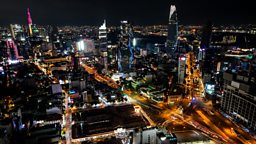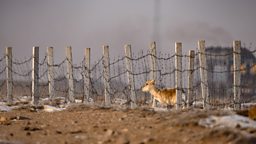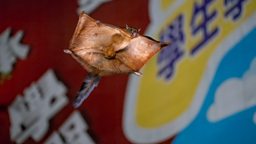The challenges of filming in Asia’s busiest places
By Emma Hatherley, Producer

As production on Asia began, the team discussed what specialist equipment we would need for the months of filming ahead. Thermal jackets for the Frozen North team, mosquito nets for Tangled Worlds, hiking boots for Above the Clouds. What would the Crowded Continent team, planning to film in Asia’s megacities, require? Designer sunglasses?
The aerial shots in the final film were all hard-won, and a result of experience, skill and nerves of steel.
If you had to guess which episode was the easiest to make, you might pick Crowded Continent. It required no arduous journeys to remote corners of the wilderness, no stays in inhospitable environments, no lonely months in hides. On paper, it sounds simple. As the Producer of Crowded Continent, I am undoubtedly biased and in no place to judge such a hypothetical contest. Yet I do know that, when our teams headed to some of the planet’s busiest places, we faced unique, and often surprising, challenges.
From the very start of production, we knew it was important to showcase the beautiful and diverse landscapes found across the continent, as well as the animals which live in them. Aerials would be vital, and the easiest way to film them is with drones. In recent years, drone technology has improved phenomenally: they’ve become smaller, lighter, quieter, more stable and easier to operate. Several members of the production team are qualified drone pilots, allowing them to film aerials on shoots. However, this was not the case when working in cities. Flying drones in a city, let alone a megacity, is no mean feat. Skyscrapers can interfere with radio signals, which means losing communication between the drone and the controller is a considerable risk. Hazards are present in three dimensions and high density: from electricity lines, to buildings, to traffic and pedestrians.
Flying drones in urban areas is highly regulated and often only permitted by highly qualified local drone pilots, familiar with local laws. Almost all of the drone filming for Crowded Continent was carried out by experienced local drone operators. This often meant communicating without a language in common, which added an extra dimension, and often time delay, to directing. In several cities, we were only permitted to fly within short time windows: waiting on standby for the call from air traffic control. When the phone finally rang, it was ‘all stations go’ to get the drone launched and to film all the shots we needed before our allocated slot ran out. After each city drone shoot I came away in awe of the pilot’s ability to fly close to skyscrapers, maintain laser focus in the midst of noisy traffic and pull off creative shots whilst flying to strict rules. The aerial shots in the final film were all hard-won, and a result of experience, skill and nerves of steel.

To film rhino beetles in Taipei, the capital city of Taiwan, we needed to get our timing just right. The characterful beetles appear for just a few weeks each year, and are very particular about which ash trees they gather on – favouring just a handful of the thousands planted across the city. Ordinarily, when working out the best time to film animals we rely on scientific papers, analysing years’ worth of data. But, as we found with many urban animals, there hadn’t been any long-term studies. Cities are the newest habitat on the planet and so animals living there tend to have moved in relatively recently. In Taipei, our knowledge came from an unlikely source: parents. Children in Taiwan are huge fans of rhino beetles, and thanks to intel from mums, dads and teachers, a small team consisting of myself, Researcher Henry Lin, and Cinematographer Oli Mueller found ourselves at the base of an ash tree teeming with beetles.
Despite the chaos, Oli managed to capture some epic beetle battles...
A gathering of rhino beetles is a lively event. Whilst the females focus on eating, scraping away the bark to reach the sap, the males fight over them. With their horns they can lift nearly a thousand times their own bodyweight, and enter into battle with the goal of flinging their opponent off the tree. To capture the action, we’d come equipped with a crane, high speed cameras and an entire case full of specialist close-up macro lenses. It didn’t take long for us to draw our own crowd: excited children jostling for position to watch the beetles battle. It certainly made for a livelier working environment than we were used to.
Despite the chaos, Oli managed to capture some epic beetle battles, using a specialist probe lens to film in the midst of the action. Yet, to really showcase these determined little characters, we needed to film some big close-ups, which was proving impossible on the busy tree trunk. As is sometimes the case when filming very small creatures, we needed a studio. A local school came to our rescue, kindly offering us use of an empty classroom. Amongst brightly coloured gym equipment and tiny chairs, we assembled a temporary studio – and thanks to its close proximity to the filming tree, our beetle ‘stars’ could pop in for their close-ups and be returned to the battleground in no time.

Crowded Continent offered the opportunity to tell the stories of animals living in the most unexpected places. The Western Wall in Jerusalem is a world-famous religious site that attracts millions of tourists from across the globe. It’s also an important nesting site for swifts, potentially the oldest urban nest site in the world. Every year, around eighty pairs nest in the cracks between the stones, after migrating from Africa. We were fortunate to be granted permission to film the swifts at the Western Wall but working at such a busy location inevitably meant adapting our approach. To avoid distracting the worshippers, we kept our filming equipment to a minimum: most shots were obtained with a single camera and, to film people near the wall we used a handheld gimbal.
The final film is thanks to countless people all over the world working together: a truly crowded collaboration.
In order to effectively tell the story of the swifts returning to the Middle East to breed, we wanted to film swifts inside a nest. To do this, we installed high resolution cameras into a specially-adapted nest box. The cameras could be operated from back in the UK, and Assistant Producer Sam Rowley put his social life on the backburner for three months, to monitor the images and film the swifts. Days, nights, evenings and weekends: from February to May, Sam could not be separated from his laptop. By virtually accessing the nest box whenever and wherever, from his house, to the office, to the pub, Sam was able to film key moments in the nest box.
Working around people wasn’t always easy but, on reflection, it did come with a one invaluable advantage: working around people. From providing us with vital information, to permitting us to film, assisting on location or simply tolerating our presence, it’s impossible to count the number of individuals who played a role in the episode. The final film is thanks to countless people all over the world working together: a truly crowded collaboration.




































